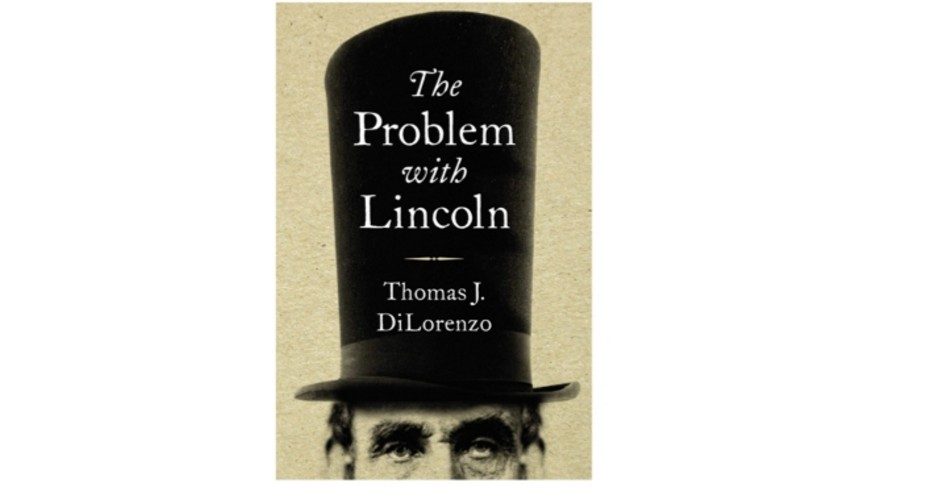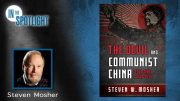
The Problem With Lincoln, by Thomas J. DiLorenzo, Regnery History, 2020, viii + 248 pages, hardcover.
Not only have more biographies and books been written about our 16th president, Abraham Lincoln, than any other president of the United States, I think it is safe to say that few men have had as much written about them as Abraham Lincoln. The problem with most of these works about Lincoln is that they are more hagiographical than historical. Thank God that Thomas J. DiLorenzo has devoted a good part of his life to rectifying this historical injustice.
Although DiLorenzo is an economist by education and training, he is also quite the historian of American history. DiLorenzo is a senior fellow at the Ludwig von Mises Institute in Auburn, Alabama, and former professor of economics at Loyola University Maryland, where he is now professor emeritus. DiLorenzo is also a prolific writer. Not only has he written many scholarly articles for academic journals, he is also widely published in more popular outlets such as the Wall Street Journal, USA Today, Barron’s, and other national media outlets. He is the author or coauthor of 17 books, including Hamilton’s Curse and How Capitalism Saved America: The Untold History of Our Country, from the Pilgrims to the Present. Most notably, however, he has written three books on Lincoln.
In The Real Lincoln: A New Look at Abraham Lincoln, His Agenda, and an Unnecessary War (2002), DiLorenzo portrayed Lincoln “as a man who devoted his political career to revolutionizing the American form of government from one that was very limited in scope and highly decentralized — as the Founding Fathers intended — to a highly centralized, activist state.” In Lincoln Unmasked: What You’re Not Supposed to Know About Dishonest Abe (2006), DiLorenzo presented “a litany of stunning new revelations” to explode the most enduring myths about Lincoln and offered “an alarming portrait of a political manipulator and opportunist who bears little resemblance to the heroic, stoic, and principled figure of mainstream history.” Now, in his newest book The Problem With Lincoln, DiLorenzo shows how Lincoln “overturned our original constitutional order, violated the rights of Americans both North and South, massively inflated the federal government, and plunged the nation into a wholly unnecessary war.”
The Trouble With Lincoln contains 10 chapters and is supplemented by 10 valuable appendixes. The book has no preface or introduction, but the first chapter, “Un-Founding Father,” serves as the book’s introduction since it contains brief synopses of chapters two through 10. Every chapter destroys numerous widely held myths about Lincoln as it presents the unvarnished truth about “honest Abe.” The appendixes are all documents from the Lincoln era that relate to Lincoln, slavery, or the ratification of the Constitution. The book concludes with endnotes, the sources of the appendixes, and an index.
This book, says the author, is “intended to challenge the designation of Abraham Lincoln as America’s greatest president.” Although the truth about Lincoln “can be found in myriad scholarly publications and documents,” the problem “for the average citizen is that these facts are squirreled away in university libraries, the National Archives, and other such places, and they rarely make their way into the public school textbooks from which most Americans learn whatever they know — or think they know — about Abraham Lincoln.” DiLorenzo remedies this glaring deficiency by pointing out, among many other things, how Lincoln did not invade the South to free the slaves, how he promised to protect slavery forever, how he was a virulent racist, how he destroyed the Constitution, how his emancipation proclamation did not free a single slave, how he was a masterful lying politician, and how he was hated and reviled during his lifetime.
In chapter two, “The Racial Saint,” we learn that Lincoln “was not just pandering to Northern racist voters with his racist rhetoric.” Lincoln believed that “black people were inferior to whites.” He was not “in favor of bringing about in any way the social and political equality of the white and black races.” According to Lincoln, negroes should never be voters, jurors, office holders, or the spouse of a white person. Lincoln thought it “morally right” to send all blacks — including free blacks — back to Africa or to a colony in Central America. Lincoln, points out DiLorenzo, “never opposed Southern slavery, only the extension of slavery into the territories” “so that the territories could be preserved for ‘free white labor.’”
In chapter three, “The President Who Invaded His Own Country,” DiLorenzo makes the shocking statement that “there can be no clearer example in American history of an act of treason than Lincoln’s invasion of the Southern United States.” The Constitution defines treason against the United States as “levying war against them, or in adhering to their enemies, giving them aid and comfort” (Art. III, sec. 3). And as DiLorenzo reminds us: “In all of the founding documents the phrase ‘United States’ is always in the plural.” Because Lincoln “never conceded that the Confederate government was legitimate,” and that “the Southern states were always in the Union,” when he invaded the South “he was invading his own country.”
In chapter four, “War Crimes,” we learn that Lincoln’s armies terrorized civilians, stole their property, slaughtered their livestock, destroyed their infrastructure, and burned their farms, houses, and businesses. Lincoln “was as much of a hands-on commander in chief as has ever existed in America,” and “was always fully informed of what his generals were doing in the field.”
In chapter five, “Lincoln’s Greatest Failure,” DiLorenzo identifies Lincoln’s greatest failure as his failure to peacefully end slavery. All throughout the world, slavery was ended without war, death, and destruction — except in the United States. Lincoln’s “invasion of the Southern states” was not “necessary to end slavery. The Emancipation Proclamation that Lincoln issued on January 1, 1863, “freed nobody because it applied only to states or parts of states ‘in rebellion against the United States’ that were under the control of the Confederate government.” DiLorenzo asks what should be obvious: “If the Emancipation Proclamation freed the slaves, why was the Thirteenth Amendment, which actually did put an end to legal slavery, necessary?” .
In chapter six, “King Lincoln,” DiLorenzo shows that Lincoln was a de facto dictator. Lincoln scholars even admit this, but excuse it by saying that he was a benevolent dictator who did what was necessary to save the Union, as if that justifies hundreds of thousands of deaths. Lincoln “eviscerated the U.S. Constitution.” He essentially “resurrected the Sedition Act.” He “arrested and imprisoned judges,” and wanted to imprison the chief justice of the United States for the crime of enforcing the U.S. Constitution.” He imprisoned “tens of thousand of Northern state citizens” for “criticizing the government.” He “shut down more than three hundred opposition newspapers in the Northern states.”
In chapter seven, “Consolidation Bottomed on Corruption: The Hamilton-Clay-Lincoln Agenda,” DiLorenzo explains the connection between Lincoln and Alexander Hamilton and Henry Clay. Lincoln was “the political heir to the economic nationalist tradition in American politics.” DiLorenzo describes this as “high protectionist tariffs to protect the Northern corporate plutocracy from international competition (at the expense of consumers); what we today call corporate welfare for the Northern corporate plutocracy in the form of ‘internal improvements’ subsidies (taxpayer-funded, for road-, canal-, and railroad-building); and a national bank controlled by politicians that would supply cheap credit for the politically connected Northern corporate plutocracy.”
In chapter eight, “Lincoln’s Lies,” DiLorenzo contrasts the true nature of the government of the United States under the Constitution (a voluntary union of sovereign states) with Lincoln’s view of a “sacred union” of federal supremacy over the states maintained by force.
In chapter nine, “The Invention of ‘Saint Lincoln,’” DiLorenzo points out how each year since his death, Lincoln has “become more religious,” thanks to the Republican Party of his day turning him “into a Christ-like figure.” Yet, Lincoln was regarded by his contemporaries as an “open infidel” and “lifelong atheist” who “had no faith.” The Lincolns held “at least eight seances in the White House in attempts to communicate with their deceased sons.” In this chapter, DiLorenzo also shows the connection of Lincoln with Karl Marx and exposes the fake Lincoln quote industry.
Chapter 10, “What the Lincoln Myth Means for Americans Today,” details the growth in government and destruction of federalism resulting from the Civil War. The voluntary union of the states was transformed into a coerced union with all power centralized in Washington, D.C. From 1865 onward, “The federal government would be the sole judge of the limits, if any, of its own powers.”
There is so much truth packed into every chapter of The Problem with Lincoln that a brief review such as this cannot do the book justice. Every college student should be given a copy before he begins school in the fall. I cannot recommend the book highly enough.



